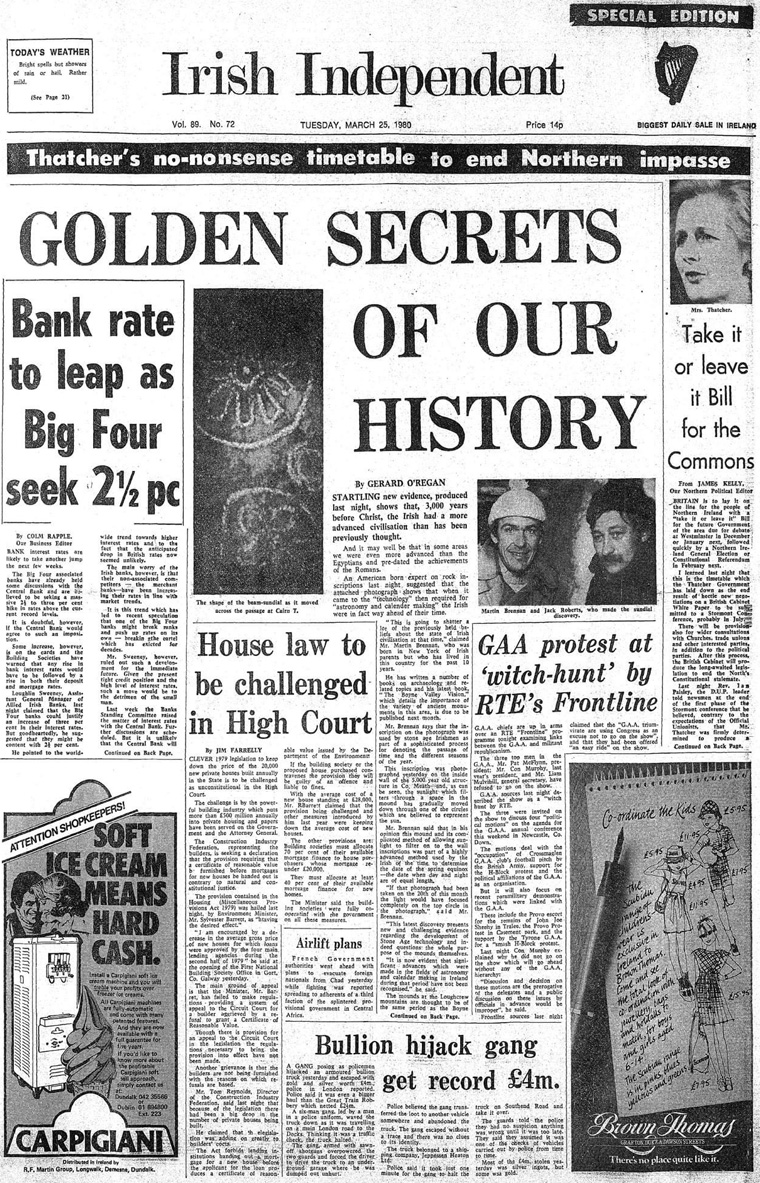Martin Brennan
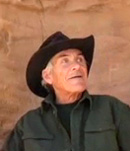 Martin
Brennan (1942-2023) was an Irish-American author whose research work and books in
the 1980's changed how we look at the sophistication of Ireland's Stone Age
monuments. Martin challenged conventional opinion about the function of
Newgrange,
Dowth,
Loughcrew
and other passage tombs of Ireland and presented
overwhelming evidence showing that many of these 5,000 year old monuments were
used as astronomical observatories. His books, The Boyne Valley Vision and
The Stones of Time, both published in the 1980s, have stood the test of time.
Martin
Brennan (1942-2023) was an Irish-American author whose research work and books in
the 1980's changed how we look at the sophistication of Ireland's Stone Age
monuments. Martin challenged conventional opinion about the function of
Newgrange,
Dowth,
Loughcrew
and other passage tombs of Ireland and presented
overwhelming evidence showing that many of these 5,000 year old monuments were
used as astronomical observatories. His books, The Boyne Valley Vision and
The Stones of Time, both published in the 1980s, have stood the test of time.
Martin Brennan was born of Irish parents in Brooklyn, New York. He was a student of Pratt Institute, where he majored in Visual Communication. He worked briefly in graphic design before going to Mexico where his interests in prehistoric rock inscriptions, ritual and traditional art developed. He moved to Japan for some years and there the scholar Kimitaro Kitamura urged him to go to Ireland and study ancient Irish culture. He lived in Ireland for ten years, working in graphic design and pursuing his study of megalithic art.
In December 2009 Martin Brennan returned to Ireland after a 25 year gap to headline the Boyne Valley Revision Winter Solstice Conference at Newgrange. He revealed fascinating new data from Mexico relating to ancient alignments and the Mayan calendar, and the resonance and synchronicity between his discoveries in Mexico and those he made in Ireland in the 1980s.
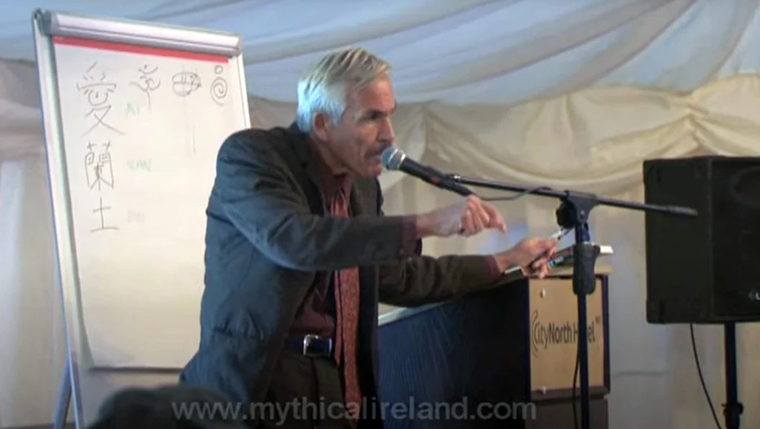
Martin Brennan at the 'Boyne Valley Revision' conference at the Newgrange Lodge in December 2009
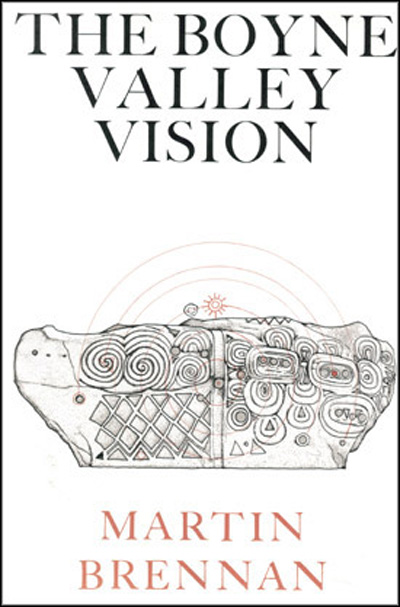 The Boyne Valley Vision
by Martin Brennan. Published by The Dolmen Press in 1980.
The Boyne Valley Vision
by Martin Brennan. Published by The Dolmen Press in 1980.
In this book Martin Brennan presents an entirely new interpretation of these monuments, one which challenges the conclusions of earlier studies and offers conclusive evidence which radically changes our knowledge of megalithic culture in Ireland. The Boyne Valley Vision is a personal step-by-step account of a quest that has resulted in some of the most astounding and profound archaeological decipherments of our time.
Martin Brennan demonstrates in his text and in some ninety drawings and figures from his pen the vision of the universe transmitted by the artists of megalithic Ireland in their designs carved in naked rock. He shows that the ideas expressed by these artists are more substantial than the stones on which they are incised. His study exposes for the first time an entire cosmology, a vocabulary of symbols, the sundials, the calendar and other scientific tools of the oldest culture known to us.
Purchase at Amazon.com or Amazon.co.uk
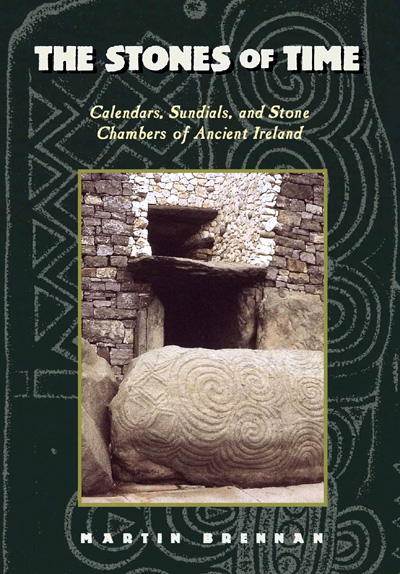 The
Stones of Time - Calendars, Sundials and Stone Chambers of Ancient Ireland by Martin Brennan.
First published in 1983 as The Stars and the Stones.
The
Stones of Time - Calendars, Sundials and Stone Chambers of Ancient Ireland by Martin Brennan.
First published in 1983 as The Stars and the Stones.
Older than the pyramids and predating Stonehenge by at least a thousand years, the stone complexes of ancient Ireland have been extensively excavated and studied, yet they have refused to give up their mystery. Archaeologists have speculated that the chambers were tombs.
Art historians have tried to interpret the enigmatic designs painstakingly carved into the faces of the stones. But the real function of these ancient structures can be understood only when the art and architecture are seen to be parts of a unified whole. More ...
Martin Brennan used a different kerbstone numbering system at Knowth to the George Eogan K1 to K127 system. He used a system based around North, South, East and West, see comparison table.
Golden Secrets of our History
By Gerald O'Regan - The Irish Independent - 25 March 1980Startling new evidence, produced last night, shows that, 3,000 years before Christ, the Irish had a more advanced civilisation than has been previously thought.
And it may well be that in some areas we were even more advanced than the Egyptians and pre-dated the achievements of the Romans.
An American born expert on rock inscriptions last night suggested that the attached photograph shows that when it came to the "technology" then required for "astronomy and calendar making" the Irish were in fact way ahead of their time.
"This is going to shatter a lot of the previously held beliefs about the state of Irish civilisation at that time," claimed Mr. Martin Brennan, who was born in New York of Irish parents but who has lived in this country for the past 10 years.
He has written a number of books on archaeology and related topics and his latest book, The Boyne Valley Vision which details the importance of the variety of ancient monuments in this area, is due to be published next month.
Mr. Brennan says that the inscription on the photograph was used by stone age Irishmen as part of a sophisticated process for denoting the passage of time and the different seasons of the year.
This inscription was photographed yesterday on the inside wall of the 5,000 year old structure in County Meath and, as can be seen, the sunlight which filters through a space in the mound has gradually moved down through one of the circles which are believed to represent the sun.
Mr. Brennan said that in his opinion this mound and its complicated method of allowing sunlight to filter on to the wall inscriptions was part of a highly advanced method used by the Irish of the time to determine the date of the spring equinox - the date when day and night are of equal length.
"If that photograph had been taken on the 20th of this month the light would have focused completely on the top circle in the photograph." said Mr. Brennan.
"This latest discovery presents new and challenging evidence regarding the development of Stone Age technology and indeed questions: the whole purpose of the mounds themselves. "It is now evident that significant advances which were made in the fields of astronomy and calendar making in Ireland during that period have not been recognised." he said.
The mounds at the Loughcrew mountains are thought to be of the same period as the Boyne Valley mounds about 3,200 and places them in a much earlier period than the Egyptian pyramids," he added. Mr. Brennan said that the series of mounds in the area could now be seen as operating as a "gigantic sundial for the year" and suggested that it is "amazing" that after 5,000 years the structure is still functioning in its original capacity.
He pointed out that this obviously required highly developed building skills and that this sophistication was matched by considerable advancement also in the fields of astronomy and calendar making.
"This method for regulating the solar year is the earliest known attempt at calendar making and sundailling," he said.
The precision, skill and imagination required for these constructions is almost unbelievable - this was a seasonal sun dial which went far beyond the needs of a primitive agricultural society.
"It appears that this area of Co. Meath was used by prehistoric Irishmen as a giant astronomical calendar," said Mr. Brennan.
"We could be entering a new era in the bid to understand our roots," he added.
Martin Brennan - Obituary
Martin V. Brennan, author, artist, megalithic discoverer, pioneer by Toby R Hall - December 2023Martin Vincent Brennan, 'Morsheen', was born of Irish parents from Roscommon and Galway on 16th June 1942 in Brooklyn, New York. The family lived close to the library, Natural Museum and Prospect Park. These three locations had an inspirational and creative impact on his life. The boy brought home a book on Chinese writing and glyphs, an art he continued throughout his life. He was a Daykeeper living and exploring time through the Azteca-Mayan Cosmology for many decades in Mexico.
In the Natural Museum his young mind was fascinated with wooden Mayan Temple reproductions and the Meso-American heritage. In Prospect Park, which was shaped and modelled around the shape of the island of Ireland, the land of his forbears, he embraced nature and his Irish roots. After college, his formal art training was in the Pratt Institute in Brooklyn, in visual communications, where guest lecturer, author and mythologist Joseph Campbell, presented the cross-cultural concept of the The Hero's Journey. During his time in Pratt he deepened his fascination with the Meso-American culture. From Pratt he moved into an advertising agency as a design and graphic artist. However, he was not destined to spend his days working the city and 'mad men' advertising industry - he was an explorer, a maverick. Growing up Brooklyn he had an exciting youth.
He was athletic and excellent runner and basketball player. In college he was rarely beaten on the track. He put this down not just natural athleticism but to his mental preparation, before the starting gun he envisioning himself as a horse. He was natural Shaman who connected with both the natural and spiritual worlds throughout his life.
He moved from New York to Mexico study Maya prehistoric rock inscriptions, art and ritual. He lived with an Indian family deep in Jalisco mountains, where he did extensive field work on local art and Shamanism. Whilst in Mexico, he met author Alan Watts, who was interested to learn more of Martin's Mayan research and arranged that he bring his findings along to show him and his friends the Randolph's who had an interest in art and the Meso American culture.
The meetings lead to new phase of his journey, Japan. The Randolphs helped him travel to and enrol in Shotokugi Zen Monastery, Japan's first/oldest Zen Monastery dating from 1322, where he studied Oriental art and calligraphy at Shotokugi. He also studied also Akido in which he acquired a Black Belt. He remained active at Akido, basketball and swimming into his 70s. By combining art and aikido he fundamentally embraced the ways of brush, (and pen) and sword. He was happiest when he was drawing. He embodied the way of artist, scholar, warrior and shaman. His Japanese Zen and Akido training along with his Mexican fieldwork and study of Shamanism, art and his visual communications experience made a good grounding for his next area of focus, the Boyne Valley monuments and Irish Megalithic culture - areas in which he was to make unique groundbreaking and valuable discoveries.
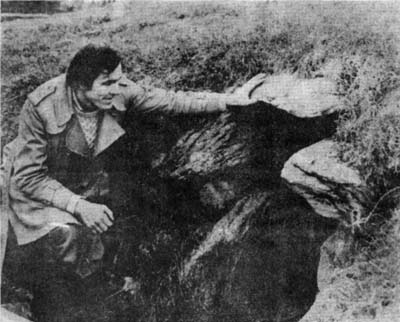 This
move to Ireland came about through his esteemed Japanese, Celtic scholar,
teacher who suggested he travel to Ireland land of his parents and study
the ancient culture. In 1970 he left Japan for Ireland and the Boyne Valley.
He, settled in top floor flat in Fitzwilliam Street. He worked in
Graphic Design and Advertising, working at the Peter Owen's Agency.
He founded an official Akido Dojo in Trinity college. Several of his
Japanese teachers visited to celebrate the founding of the Akido project
and to initiate the work into Boyne Valley culture as a Cultural Spiritual undertaking.
This
move to Ireland came about through his esteemed Japanese, Celtic scholar,
teacher who suggested he travel to Ireland land of his parents and study
the ancient culture. In 1970 he left Japan for Ireland and the Boyne Valley.
He, settled in top floor flat in Fitzwilliam Street. He worked in
Graphic Design and Advertising, working at the Peter Owen's Agency.
He founded an official Akido Dojo in Trinity college. Several of his
Japanese teachers visited to celebrate the founding of the Akido project
and to initiate the work into Boyne Valley culture as a Cultural Spiritual undertaking.
Between the glyphs on the kerb stones, drawings and photographs, Martin soon deduced that the enigmatic designs in part were depictions of astronomical symbols, the sun and moon and cosmological cycles. The fruits of this research are to found in his two Irish books, The Boyne Valley Vision, Dolmen Press 1979 and The Stars and the Stones, Thames and Hudson 1982. Republished by Inner Traditions USA in 1994 as, The Stones of Time.
Martin handcrafted his books. He wrote them in his distinctive longhand and they were adorned with his beautiful and distinctive drawings. He would start a book by designing the cover, meet with the publisher and progress from there. His enthusiastic and charismatic presentations of the research intrigued and found favour with the eminent publishers, Dolmen Press and Thames and Hudson.
This latter was helped by front page news stories of groundbreaking discoveries of the sun entering the recess's of the chamber cairns, Cairn T and Cairn L, in the Loughcrew Hills on the vernal equinox and cross quarter day respectively and his friendship author John Michell. To catch the sun entering the chambers one had to be up early and drive to the Boyne Valley or Loughcrew Hills and to climb the hill to be in place for the sun or moon to shine in. The logistics of this led to the need for one or two cars and small group of observers to be in the selected cairns. This loose collective of megalithic enthusiasts went under the title Stonelight. The equinox sun beam was the bringing to life of the 5,000 year old glyphs as the sun beam moved across the backstone in Cairn T.
The sunbeam penetrating the dark cairn/womb and illuminating the symbols breathed life and light into the monument as it revealed its astronomical function as a calendrical device of great antiquity and sophistication. Martin hoped with the publication of The Stars and Stones, the catch-all diminutive tomb theory/burial mound label would be laid to rest and the abodes of the Daghda, Aengus and the pantheon of historic/mythic residents of the wonderful cairn/residences/sacred mounds would be recognised as sacred, scientific edifices - 'Temples of the Ancestors'.
Shortly after the publication of The Stars and Stones, Martin unexpectedly needed to return to New York. Regrettably the revelations of "the golden secrets of our past" as astromegailtic-cosmological temples was ignored and even ridiculed. In part, it must be said because these discoveries came from outside the doors of the establishment dogmatic tomb theory orthodoxy.
Martin moved from New York to Boulder, CO, where he taught and trained a local basketball team based on Akido principles. Here he produced his third book, The Hidden Maya (1998, Bear and Company) in which he decoded the enigmatic hand sign language depicted in Aztec and Mayan codices, rock carvings and pottery. His breakthrough for came from his realisation that the sign language of plains Indian's had roots in the earlier Meno-American hand sign language and was able reverse deduce these hand gestures.
He did extensive work in decoding the Codex Borgia and Azteca-Maya Calendar system. To his last day kept Azteca-Mayan day-keeping journals where he wrote in Gaelic, Chinese, Japanese, and with Azteca-Mayan glyphs that in detail recorded the subtle intricacies of each day. He was regarded as an author's author. Publishers liked to publish him for unique scholarship rather than just projected sales; they recognised the intrinsic value of his work.
In 2009, Anthony Murphy author and curator Mythical Ireland, instigated a plan with Stonelight friends of Martin bring him 'home' for a winter solstice conference in the Boyne Valley. This trip was a joy for Martin as he met many old friends and good number of archaeologists including George Eogan, excavator of the extraordinary Knowth megalithic complex. Martin had hoped that his astro-calendrical discoveries would be accepted and bury the the tomb moniker after the 30 year 'acclimation' period. Alas, he did not live long enough to see that change.
Martin died on 1st November 2023 after a fall and short hospitalisation, close to Puerto Vallarta, Mexico where he lived for over a decade. He will be greatly missed by many who hoped and expected that he would live to see the publication of more of his deep insights into nature of time. He was an erudite maverick, a lifelong bachelor, genius, author, teacher and shaman who lived a full life on his own terms. His decade in Ireland added greatly to the comprehension of our nation's scientific and spiritual roots. May he rest in peace.
Toby R Hall - December 2023
Boyne Valley Private Day Tour
 Immerse yourself in the rich heritage and culture of the Boyne Valley with our full-day private tours.
Visit Newgrange World Heritage site, explore the Hill of Slane, where Saint Patrick famously lit the Paschal fire.
Discover the Hill of Tara, the ancient seat of power for the High Kings of Ireland.
Book Now
Immerse yourself in the rich heritage and culture of the Boyne Valley with our full-day private tours.
Visit Newgrange World Heritage site, explore the Hill of Slane, where Saint Patrick famously lit the Paschal fire.
Discover the Hill of Tara, the ancient seat of power for the High Kings of Ireland.
Book Now
Home
| Newgrange
| Knowth
| Dowth
| Hill of Tara
| Fourknocks
| Loughcrew
| More Places
| Labyrinths
| Local Info
| Art Works
| Articles
| Images
| Books
| Links
| Boyne Valley Tours
| Contact

